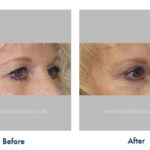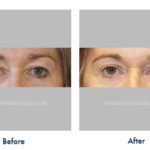Home > Procedures > Face > Eyelid Reduction
Eyelid Reduction
Eyelid Reduction Surgery (eye lift, blepharoplasty)
Eyelid reduction, also known as blepharoplasty, is an operation to remove the excess skin and/or fat from around your eyes so that you have a more alert and youthful appearance. The upper, lower, or both eyelids are the areas where eyelid reduction is performed. Selected patients may also opt for non-surgical Blepharoplasty (See below).
Your eyes are your most important facial feature. They are what people notice first when they meet you and the feature they focus on most. The appearance of our eyes plays a large part in how young, attractive and vital we appear.
As you age the skin around your eyes loses its elasticity. You may develop loose folds of skin on the upper eyelids and deepening creases on the lower lids. As well as loose skin, the muscles in this area slacken so that any fat bulges forward, giving the appearance of bagginess.
Over time, the skin around our eyes creases, muscles weaken, and folds and bags develop. These changes come about for a number of reasons:
- Heredity – this is an important factor. Take note of family features that you may have inherited. Facial structure is also part of heredity.
- Sunlight and ultraviolet rays – These damage the skin, especially the delicate area around the eye when we squint, causing muscle thickness below the eyelashes.
- Ageing – As already mentioned, ageing causes stretching of the eyelid skin and leads to excess folds, wrinkles, and sagging of the fat around the eye, which appears as bulges in both the upper and lower lids.
By removing excess skin and bags, eyelid surgery, eyelid reduction or blepharoplasty can improve many of these problems. It cannot, however, totally eradicate all eyelid creases. Doing so would create excess tension on the eyelids and result in an overcorrection. Nor can surgery remove laughter lines at the sides of the eyes or malar bags (bulges high on the cheekbones).
Eyelid surgery or eyelid reduction has evolved significantly in the last 15 years. The aim of the surgery is to give you a naturally refreshed appearance.
- In the upper eyelid, over zealous removal of fatty tissue excess has been shown to produce a hollow appearance, which can make the eyes of a patient look doll-like.
Eyelid reduction may be performed to remove the wrinkles on the area within the bony margins of your eye sockets. However, eyelid reduction will not improve crows feet and other wrinkles around the area. It is important to remember that this procedure will not lighten the dark colouring beneath the eyes.
Your Consultation
At your consultation, Mr Nduka will ask about:
- Your general medical history, any previous eyelid surgery and any possible thyroid or kidney disease as these can produce swelling of the eyelids.
- Any history of eyelid conditions and dryness of the eyes.
Mr Nduka will also point out normal differences in facial symmetry you may never have noticed, and describe the results you can expect from your surgery and the positioning of the scars. It is very important to discuss what you find most objectionable about the appearance of your eyelids and to try to define what you would like to see as an end result.
- Sometimes, a forehead lift can correct heavy upper eyelids.
- Mr Nduka will then explain the kind of changes you can expect from each procedure, as well as its inherent limitations and risks.
New techniques allow for lifting and support of the lateral part of the eyebrow through an upper eyelid procedure, which can combine a forehead lift and upper lid blepharoplasty in a smaller procedure. It may also be possible to reduce the frown lines between the eyebrows during an upper eyelid blepharoplasty, by directly accessing the muscles that produce the lines and weakening them.
Non-surgical blepharoplasty
This relatively new technique uses heat (from electrical current, or laser) to tighten the upper eyelid skin. It has the advantage of being a relatively fast technique, taking approximately 30 minutes, and avoiding an incision. However, only surgery can get rid of significant fat that should be sculpted, which may cause disappointment with the results. Also, whilst this technique is quick, the recovery is typically longer in terms of healing of the burns. Performing surgery around structures as delicate as the eyes requires years of training. Unfortunately, with the introduction of non-surgical blepharoplasty, non-surgeons are performing the procedure, even GPs and skin doctors without a surgical qualification. Complications such as extensive scarring, skin persistent skin pigmentation, and asymmetry are significant.
What to expect from your surgery
Mr. Nduka can perform eyelid surgery under local anaesthesia, with or without sedation, or under general anaesthesia. The patient may also have it as a day case procedure or at the same time as a facelift.
Upper Eye
In the surgery, Mr. Nduka will place the incision in the natural crease line approximately one centimetre above your eyelashes,extending a little into the outer side area of the eye.
- He will trim excess skin and remove any fat in the area at the side of the nose.
- In instances where significant fullness is present in the side of the eyelid, a small amount of fatty tissue may also be removed from that area.
- Subsequently, he will close the incision most commonly with one continuous stitch.
Lower Lid
- Mr. Nduka will place the incision just below the eyelashes and run out to the natural “laughter line” area.
- He will then elevate tissues and partly remove and redrape excess fat.
- During this operation, a light uplift of the cheek fullness will contribute to a more beautiful appearance of the cheek area.
- Finally, the procedure lifts the skin upward and outwards, ensuring that there is no tension. The overlapping skin is removed before the incision is closed.
If excess skin is minimal, it is sometimes possible to perform this lower lid surgery without external scars, a procedure known as transconjunctival blepharoplasty. This allows for contouring of the lower eyelids and circles under the eyes, without leaving external scars. It can be accompanied by resurfacing of the lower eyelid either using chemical peel or laser.
After your surgery
You may find that you experience excess tears or abnormal pigmentation of the eyelid skin, but this should be temporary. Mr. Nduka will advise you to take precautions he has listed below:
- To avoid bleeding, you should not stoop or carry out vigorous activities for five days after your surgery.
- You may gently splash your eyelids with water but do not rub in any way.
- Antibiotic eye ointment should be applied for three or four days and you should not use eye makeup for the first week or two.
- It is important to avoid aspirin after your surgery. You may control any discomfort around the eyelids by taking mild painkillers such as paracetamol. You may also find the use of artificial tears helpful in the first few days.
- As you will not be able to wear contact lenses for some time after your surgery, it is useful to have a pair of spectacles to hand.
- It is essential to wear large sunglasses after your surgery.
Your stitches should normally be removed 3 to 7 days after your procedure. Your scars will be pink for some weeks, or months. Scars in the “crows feet” area may become lumpy for a while but should flatten in time. You may begin to gently massage the area by 2 weeks after surgery to help flatten the scar.
The Risks
- As with any surgery, bleeding and infection can occur. Bleeding might require a return to the operating theatre to avoid damage to the eye. Infection is usually readily treated with antibiotics, extending the course of treatment that you will have received after your surgery.
- Occasionally, what appears to be a transparent sack of fluid develops and covers part of the white of the eye mostly in the outer corner. This should settle on its own, but it is useful to use eyelid lubricants regularly. Seek help if it continues for any length of time.
- A scratch on the cornea (the surface of the eye itself) while not serious, can be irritating and may take several days to heal.













